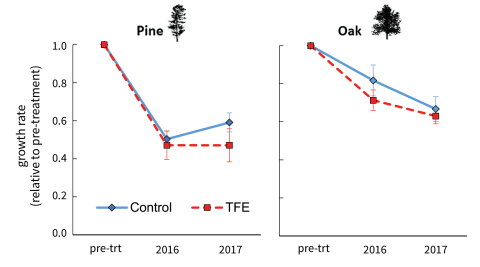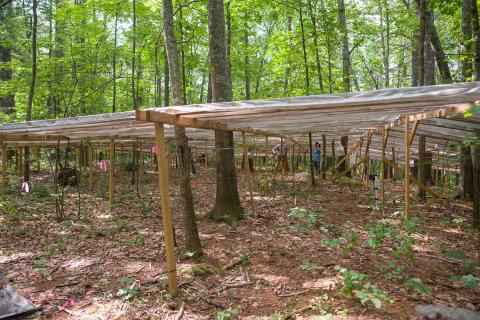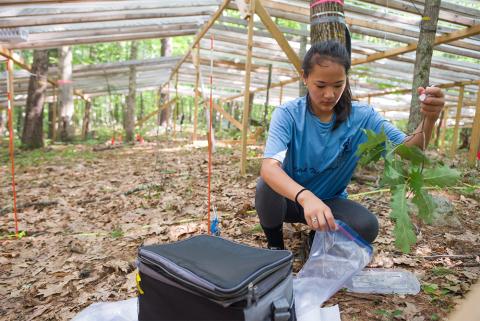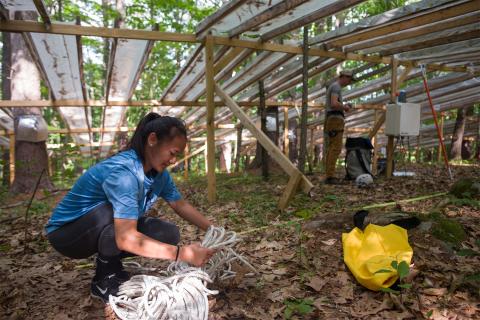Key Findings

Simulated major drought conditions showed that dominant northeastern tree species are sensitive to moisture stress but differ in drought survival strategies.
White pine trees avoid damage from drought by quickly closing their stomata to reduce water loss, which may help them survive longer drought periods but significantly reduce growth.
Oaks limit drought impacts by accessing deeper soil water, continuing photosynthesis and taking longer to lose water while in drought, but may be more vulnerable to severe droughts.
About the Co-Author

Heidi Asbjornsen, Professor of Natural Resources and the Environment
Contact information: Heidi.Asbjornsen@unh.edu, UNH Ecohydrology Lab
This research was published in the INSPIRED: A Publication of the New Hampshire Agricultural Experiment Station (Winter 2023)
Researchers: H. Asbjornsen, M. Vadeboncoeur, Z.C. Berry, A. Coble, K. Jennings and C. Mcintire
Climate change is expected to bring a warmer, wetter and more variable climate to the Northeast, including more frequent and severe droughts. Despite the potential wide-ranging implications of drought on forest health and ecosystem services, little is known about the capacity of different northeastern tree species to respond, adapt to and survive. This study considered how dominant tree species vary in their sensitivity and response to moderate and extreme drought. The research helped provide the first assessments of physiological and soil moisture thresholds that lead to abrupt changes in tree species’ response to drought and how the species vary in their ability to recover growth and function after a drought.
Simulating drought
Humid temperate regions around the world are expected to become simultaneously wetter (greater mean precipitation) and drier (more prolonged droughts), and climate patterns in the northeastern U.S. over the past century already reflect these trends. Recent severe summer droughts have occurred in southeastern New Hampshire in 2016 and 2020.
While reports of massive tree mortality as a result of drought are rare for this region, scientists also lack a sound understanding of the sensitivity and response of these temperate forest ecosystems to extreme drought. Given the key role of northeastern forests in carbon storage and in providing a range of ecosystem services to society, improving understanding of drought effects on these forests is critical to predicting future change and to managing forests for climate adaptation.
Two important indicators of drought response include how species regulate their stomates—small pores on the leaf surface that allow carbon dioxide in for photosynthesis and release water into the atmosphere—and woody stem growth—an integrated measure of how physiological responses affect productivity. The occurrence of thresholds—or abrupt changes in ecological response to a stressor—also provide a useful framework for understanding drought interactions. This information can help inform forest management practices to promote more climate resilient and adaptive forest ecosystems in the future through, for example, the application of thinning treatments and assisted migration plantings.
To better understand the effects of drought on northeastern forests, a drought experiment (Figs. 1 and 2) was established in 2016 at UNH’s Thompson Farm to simulate an extreme drought event by removing 50 percent of the throughfall rain for at least four growing seasons. Data were collected for soil moisture, tree diameter growth, litterfall, leaf gas exchange, sapflow (a measure of tree water use, or transpiration), stable isotopes of carbon (an indicator of water use efficiency) soil nutrients, decomposition, fine root production and soil respiration. The first year of the experiment coincided with the 2016 extreme drought, which was the driest summer since 1997. When this natural drought was superimposed on the throughfall exclusion, it created the most extreme drought experienced by these trees in their lifetimes.
Species-based response to drought
Results show that while both species—white pine (Pinus strobus) and red oak (Quercus rubra)—significantly reduced their water use in response to increased moisture stress, white pine exhibited greater stomatal sensitivity, sharply reducing its water uptake in response to soil drying. This is reflected in the different soil moisture thresholds that triggered strong stomatal closure (measured as reduced sapflow at the daily time scale) in each species: 14 percent and 10 percent soil moisture content for pine and oak, respectively (Fig. 4).
Across study years, a strong linear relationship between water-use efficiency (WUE) and precipitation for pine was discovered. The species begin conserving water when soils are not yet very dry. In contrast, the WUE and precipitation relationship for oak is nonlinear, with WUE becoming significantly lower only when severe moisture stress occurred during the 2016 drought. This is consistent with a strategy of allowing leaves to reach low water potentials that risk hydraulic damage, and only reducing photosynthesis in order to conserve water when soils become very dry.
The results indicate that both species reduced their growth significantly in 2016, but that growth reduction was more than twice as great for pines (Fig. 5). In 2017, pine trees started to show signs of recovery; however, the oaks continued to show further growth reductions and appeared to recover much more slowly.

Fig. 5: Wood growth (basal area increment in the first two treatment years relative to the last 5 years prior to the start of treatment) was reduced severely during the 2016 drought in both control and treatment pines. Growth reductions in oak were smaller in the year of the drought, but oaks compensated in 2017 following the drought (2016). Throughfall exclusion (TFE) represents data from the TFE plots.
These results suggest that red oak’s ecological strategy may be well-suited to surviving moderate droughts yet may make this species more vulnerable to extreme drought due to its inability to protect tissues from extensive damage.
The more conservative strategy of white pine may make it less competitive under moderate droughts—especially if they are repeated or prolonged—while conferring advantages for survival in severe droughts.
Related published research
- Tree Physiology: Sensitivity and threshold dynamics of Pinus strobus and Quercus spp. in response to experimental and naturally occurring severe droughts
- USDA Forest Service: Effects of drought on forests and rangelands in the United States: translating science into management responses
- Methods in Ecology and Evolution: Guidelines and considerations for designing field experiments simulating precipitation extremes in forest ecosystems
- Ecological Processes: Are Northeastern U.S. forests vulnerable to extreme drought?
- Hydrological Processes: Systematic variation in evapotranspiration trends and drivers across the Northeastern United States
- Forest Ecology and Management: Ecohydrological implications of drought for forests in the United States
This material is based on work supported by the NH Agricultural Experiment Station through joint funding from the USDA National Institute of Food and Agriculture (under Hatch award number 1022415) and the state of New Hampshire. Authored by H. Asbjornsen, M. Vadeboncoeur, Z.C. Berry, A. Coble, K. Jennings and C. Mcintire.






